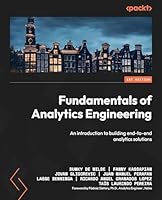
Machine Learning with Python Cookbook: Practical Solutions from Preprocessing to Deep Learning
- Length: 366 pages
- Edition: 1
- Language: English
- Publisher: O'Reilly Media
- Publication Date: 2018-04-06
- ISBN-10: 1491989386
- ISBN-13: 9781491989388
- Sales Rank: #61306 (See Top 100 Books)
This practical guide provides nearly 200 self-contained recipes to help you solve machine learning challenges you may encounter in your daily work. If you’re comfortable with Python and its libraries, including pandas and scikit-learn, you’ll be able to address specific problems such as loading data, handling text or numerical data, model selection, and dimensionality reduction and many other topics.
Each recipe includes code that you can copy and paste into a toy dataset to ensure that it actually works. From there, you can insert, combine, or adapt the code to help construct your application. Recipes also include a discussion that explains the solution and provides meaningful context. This cookbook takes you beyond theory and concepts by providing the nuts and bolts you need to construct working machine learning applications.
You’ll find recipes for:
- Vectors, matrices, and arrays
- Handling numerical and categorical data, text, images, and dates and times
- Dimensionality reduction using feature extraction or feature selection
- Model evaluation and selection
- Linear and logical regression, trees and forests, and k-nearest neighbors
- Support vector machines (SVM), naïve Bayes, clustering, and neural networks
- Saving and loading trained models
Table of Contents
Chapter 1. Vectors, Matrices, And Arrays
Chapter 2. Loading Data
Chapter 3. Data Wrangling
Chapter 4. Handling Numerical Data
Chapter 5. Handling Categorical Data
Chapter 6. Handling Text
Chapter 7. Handling Dates And Times
Chapter 8. Handling Images
Chapter 9. Dimensionality Reduction Using Feature Extraction
Chapter 10. Dimensionality Reduction Using Feature Selection
Chapter 11. Model Evaluation
Chapter 12. Model Selection
Chapter 13. Linear Regression
Chapter 14. Trees And Forests
Chapter 15. K-Nearest Neighbors
Chapter 16. Logistic Regression
Chapter 17. Support Vector Machines
Chapter 18. Naive Bayes
Chapter 19. Clustering
Chapter 20. Neural Networks
Chapter 21. Saving And Loading Trained Models







